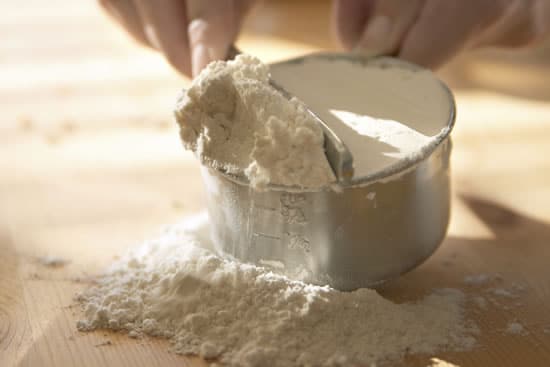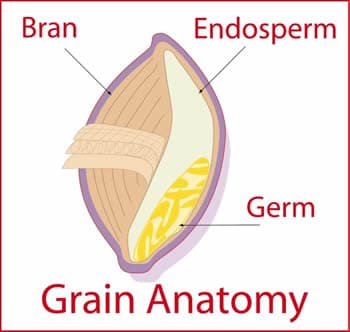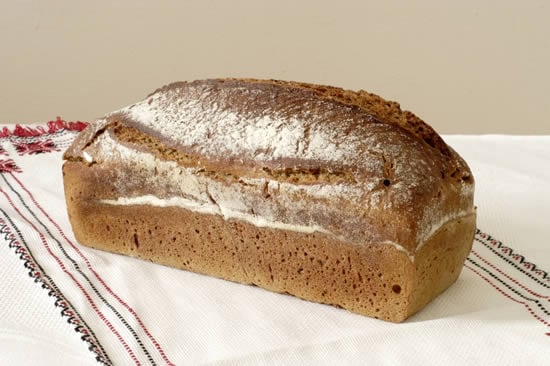The Scoop on White Flour (100% Whole Wheat Bread)
Oct 11, 2011, Updated Oct 03, 2017

White Flour is, at the same time, one of the most coveted ingredients for baking in the world and the nemesis of health-conscious eaters everywhere. White flour is the ever-present ingredient in processed foods and, probably, the single most consumed processed food in the United States (although high fructose corn syrup might give it a run for its money). Andrew asked me to explain how white flour is made, why it might be bleached and enriched, and why whole grains are a far superior choice for your health.
First, a short history lesson
What’s the deal with white flour anyway? How did we end up eating solely nutritionally deplete flour? White flour first appeared in appreciable quantity in the late 1800s with the industrial revolution. Whole wheat flour has a short shelf life; after all, it contains the germ and bran which can cause rancidity. Steam mills came with the age of industry, allowing a lot of flour to be produced quickly and transported all over the country. At the time, “flour” meant whole wheat flour, which will last only about 6 to 9 months before spoiling. To solve this short shelf life problem, millers began sifting out the germ and bran to increase the life for their flour.
In the beginning, white flour was a food of the elite. It was consumed by those with money and those in urban areas. As industry made it cheaper to produce, it became cheaper to buy. Lower income consumers imitated the wealthy and, within a few short years, white flour was the standard for everyone.
Milling
If you know that white flour is made from wheat, you’re one step ahead of a lot of people — truly, I’m not joking. White flour is made by separating the bran and the germ from the endosperm of the grain of wheat. That’s not really as complicated as it sounds — it is simply ground (typically on a high-speed, steel roller mill) and sifted to remove the fluffy white from the heavier brown. The sifting repeats until all that is left is white, fluffy flour. Fine flours, such as cake flour, are sifted more heavily. For a more in-depth description, check out this awesome video from Discovery: How It’s Made Flour.
Bleaching, Bromating, and Enriching
Often you see two types of white flour — unbleached and bleached. Bleaching is done quite simply to make flour that is truly white. Without it, white flour has a slightly off-white color. When white flour was hitting its peak, bleaching was popular to make the whitest cakes and whitest bread possible. While bleaching has become far less popular, it can still be found in many large flour brands and in most processed food.
Potassium Bromate is an enrichment added to help develop the gluten (protein) in baking. It strengthens the dough and encourages rising. Most manufacturers of flour no longer use this enrichment because research has indicated it to be a carcinogen. While it is outright banned in the United Kingdom, the FDA has not banned bromate from use in the United States, though they strongly discourage bakers from using it. Today, most manufacturers of white flour add Malted Barley Flour to bolster their flour. Malted Barley Flour is quite simply barley that has been sprouted, dried and ground into flour.
Other enrichments required by law for conventional white flour include folic acid, niacin, iron, thiamin and riboflavin. These vitamins were originally required by law (circa 1940) to help solve health issues caused by diets deficient in these essential nutrients. These nutrients are naturally found in whole wheat flour and are removed when the germ and bran are removed. Funny, isn’t it? That the government requires us to add enrichment to flour that would have been just fine had it been left whole. With so many Americans relying on white flour, though, it was necessary to help prevent things like neural tube defects in unborn babies.
In the United States, you cannot enrich organic flours — so if you want to skip the added vitamins, go organic. Alternately, in Canada all white flour must be enriched — regardless of its organic status.
Go whole grain, but know before you buy
Many of the giant flour manufacturers in the United States do not grind whole wheat flour from the whole grain. Instead, they separate all three parts of the wheat grain and re-combine them to produce whole wheat flour. It’s far cheaper to produce this way because the majority of their business is in white flour. This is completely legal in the United States and qualifies to be called whole grain. Investigate the source of your whole wheat flour before you buy.
That’s the short version of a very long story about how America became reliant on enriched white flour. For your good health, start switching to whole grain flours such as whole wheat and spelt in your baked goods, choose pasta made with whole wheat flour and pick brown rice over white rice. The nutrients naturally found in whole grains make enrichment unnecessary. Whole grains are packed with fiber and offer variety in flavor and texture. A cookie made with whole wheat pastry flour tastes as good, if not better, than one made with white flour and your conscience can rest easy knowing you fed your family something healthier.

100% Whole Wheat Bread
Ingredients
- 2 Tbsp Active Dry Yeast
- 1/4 cup Warm Water, 110 degrees
- 1/4 cup Honey, + 2 Tbsp
- 1-1/2 tsp Sea Salt
- 3 Tbsp Oil*
- 1-3/4 cups Warm Water, 110 degrees
- 6 cups Stone-Ground Whole Wheat Flour
Instructions
- Dissolve yeast in 1/4 cup warm water. Allow to proof 3-5 minutes.
- Combine next 4 ingredients and add to yeast mixture.
- Stir in flour, mix well. Knead 10 minutes. Let rise 1 hour and 45 minutes.
- Punch down. Let rise 40-60 minutes until doubled.
- Punch down and let rise a third time until doubled.
- Shape into 2 loaves and let rise until doubled.
- Preheat oven to 350 degrees Fahrenheit. Bake for 45 minutes.























Have tried everything I can think off..can not get this recipe to rise at all????????
I have to put it outside to rise. My husband likes to keep thr house at 76 degrees in the summer so unless i am canning at the same time dough wont rise properly in my kitchen.
I used coconut oil and a little less honey. This bread turned out fabolous, and it was my first time making bread!
Thanks!
Good recipe, it has been taken down from Bob’s site, not sure why. I use 1/2 cup honey (double) to make the bread really sweet. I also let it double, then put it directly in loaf pans, let it rise a little bit in there, then straight in the oven. Same results as letting it double three times as the recipe calls for. I eat it plain it’s so good!
Thanks for sharing this recipe. We have a locally grown wheat which I used instead, but I wanted to use your recipe because it didn’t call for quite as much sugar/honey as other recipes do. I didn’t want an especially sweet loaf, so I only used 2 Tbsp of honey and only 2 Tbsp of oil. I only needed a little less than 5 cups of flour. It turned out really well. To help other readers who are not used to baking bread, it’s good to note that you only add flour until the dough no longer sticks to your fingers, so this amount may vary depending on the humidity in your area. If you add too much, it will be too heavy and dry.
I find it strange that there is no counts for Calories,fats,carbs etc..for this recipe. You should be aware that people who are going to the trouble to make their own 100% stone ground bread are looking for these statistics.
I am a professional and I can make an honest guess as to what the statistics are, but I thought the bread was a little too dry. I added a 1/4 cup of almond/coconut milk and it smoothed out nicely. I also used virgin coconut oil and added flax seed, pumpkin seed and dried cranberries. I am a type 2 diabetic and Im hoping this bread will allow me a slice occasionally without the sugar spikes. We shall see. I know it will be high in carbs, but an occasional slice, I hope, will be ok.
Well….I’m just getting ready to put it in the oven but I’m not feeling very good about it turning out well. The dough just seems soooo dry. It seems more like flour just barely held together with some water than actual dough. Is this the same thing others experienced? Did I measure my flour incorrectly? Any thoughts? I’ll post again when it bakes and I’ve had the chance to try it.
Hi Shawn,
No, we do not have a picture of this, however it will have a very dense crumb. It’s a 100% whole wheat bread, after all.
I was just wondering if anybody has a picture of what the crumb should look like, preferably one that has not used vital wheat gluten, just trying to compare apples to apples. I tried making this bread and it came out really dense and just want to see what the crumb is supposed to look like.
Could it be possible that you used too much flour or that you did not knead it long enough to get the gluten working? You can test this when kneading by stretching the dough. You should be able to stretch it and see some light through it without it breaking apart. That said, this is going to be a denser/heavier loaf than if it had white flour in it. I’ll try to upload a photo of mine once we slice into it.
Great post!! Thank you so much for all of the information. Does Bob’s Red Mill separate all three parts of the wheat grain and re-combine them to produce whole wheat flour? Or can I buy that brand knowing that has not been done?
HI Kristen! Yes, you can buy Bob’s! 🙂 They grind their flour the old-fashioned way: with stone mills. I’ve been to the factory and watched it — the grains are ground up between the spinning stones, and then fall into a big collection bag. From there, the flour is packaged and sealed. That’s it. Take a look:
https://eatingrules.com/visit-to-bobs-red-mill/
How many calories in 1 slice of it ?